NCERT Solutions For Class 10 Science Chapter 9 Heredity and Evolution: In this article, we will provide you detailed NCERT Solutions For Class 10 Science Chapter 9 Heredity and Evolution. These heredity and evolution class 10 exercise answers were prepared by the best faculty in India to score good marks in the subject Science.
Also working on NCERT Solutions For Class 10 Science Chapter 9 will give you a strong foundation on the competitive exams like JEE, NEET, UPSC, etc., Read on to find out everything about NCERT Solutions For Class 10 Science Chapter 9 Heredity and Evolution .
NCERT Solutions for Class 10 Science Chapter 9 Heredity and Evolution
Before getting into the details of NCERT Solutions For Class 10 Science Chapter 9 Heredity and Evolution, let’s have an overview of the list of topics and subtopics under class 10 biology heredity and evolution NCERT solutions:
- Heredity And Evolution
- Accumulation Of Variation During Reproduction
-
Heredity
- Inherited Traits
- Rules for the Inheritance of Traits – Mendel’s Contributions
- How do these traits get Expressed
- Sex Determination
-
Evolution
- An Illustration
- Acquired and Inherited Traits
- Speciation
-
Evolution And Classification
- Tracing Evolutionary Relationships
- Fossils
- Evolution by Stages
-
Evolution Should Not Be Equated With ‘Progress’
- Human Evolution
Free download NCERT Solutions for Class 10 Science Chapter 9 Heredity and Evolution PDF in Hindi Medium as well as in English Medium for CBSE, Uttarakhand, Bihar, MP Board, Gujarat Board, and UP Board students, who are using NCERT Books based on updated CBSE Syllabus for the session 2019-20.
- अनुवांशिकता एवं जैव विकास कक्षा 10 विज्ञान हिंदी में
- Class 10 Heredity and Evolution Important Questions
- Heredity and Evolution Class 10 Notes
- Heredity and Evolution NCERT Exemplar Solutions
- Heredity and Evolution Class 10 Extra Questions
- Class 10 Heredity and Evolution Mind Map
NCERT Solutions for Class 10 Science Chapter 9 Intext Questions
Page Number: 143
Question 1.
If a trait A exists in 10% of a population of an asexually reproducing species and a trait B exists in 60% of the same population, which trait is likely to have arisen earlier ?
Answer:
Trait B, because it is present in more members of the population. It is likely to have arisen earlier and has now spread to 60% of the population. Trait A is new and has spread to only 10% of the population.
Question 2.
How does the creation of variations in a species promote survival ?
Answer:
The variations provide stability to the population of various species by preventing them from getting wiped out during adverse conditions.
The natural environment also changes, and variations in species which become suited to the environment help it to survive.
Page Number: 147
Question 1.
How do Mendel’s experiments show that traits may be dominant or recessive ?
[AICBSE 2015]
Answer:
Mendel took pea plants with contrasting characteristics tall plant and dwarf (or short) plant. On cross pollination, he got all tall plants in first generation (F
1
). But by the self¬pollination of F
1
tall plants, the plants of second generation consisted of tall and short pants in the ratio of 3 : 1. On the basis of these experiments, the characteristics appeared in first generation were called dominant (i.e. tall plants) and the characteristics that did not appear were called recessive (dwarf i.e. plants).
Question 2.
How do Mendel’s experiments show that traits are inherited independently ?
[AICBSE 2015]
Answer:
Mendel took two pairs of alternate expression of two traits and carried out dihybrid crosses by crossing them. The traits appeared in first generation were termed as dominant. When he used these F
1
progeny to generate F
2
progeny by self-pollination plants of different types were produced. In some plants both the traits were dominant, while in some plants both were recessive and some plants exhibited mixed traits. This indicates that traits are inherited independently.
Question 3.
A man with blood group A marries a woman with blood group O and their daughter has blood group O. Is this information enough to tell you which of the traits – blood group A or O – is dominant ? Why or why not ?
Answer:
This information is not enough. This is because each individual is carrying two alleles. The recessive trait can occur only when who alleles are similar. It blood group A is dominant and O is recessive, then daughter can have blood group O only when both recessive alleles occur together in mother, and father has one allele of O and other of A.
Question 4.
How is the sex of the child determined in human beings ?
OR
“The sex of a newborn child is a matter of chance and none of the parents may be considered responsible for it.” Justify this statement with the help of a flow chart showing determination of sex of a newborn.
[CBSE (Delhi) 2013]
Answer:
Half of the male gametes (sperms) carry X chromosome and other half carry Y chromosomes. All the female gametes carry only X chromosomes. When a sperm fertilizes an egg, the following situations become possible.
- (i) When a sperm carrying X chromosome fertilises an egg that contains only X chromosome), the resulting zygote develops into a female (XX condition).
- (ii) When a sperm carrying Y chromosome fertilises an egg (that contains only X chromosome), the resulting zygote develops into a male (XY condition).
Thus there are 50 – 50 chances of a male or female child and none of the parents may Sex determination in humans be considered responsible for it.
The sex-determination mechanism is shown alongside.
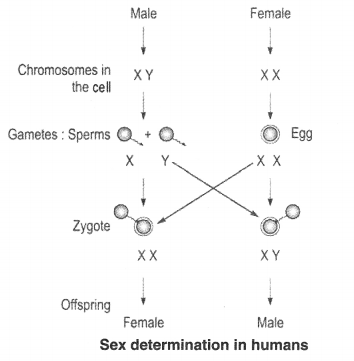
Page Number: 150
Question 1.
What are the different ways in which individuals with a particular trait may increase in a population ?
Answer:
Different ways in which individuals with a particular trait may increase in a population are as follow :
- If it gives the benefit of survival through natural selection.
- Due to a sudden increase in a particular trait in a population, i.e., by genetic drift.
Question 2.
Why are traits acquired during the life-time of an individual not inherited ?
Answer:
The traits acquired during the life-time are changes in the non-reproductive cells of the organisms and are not capable of being passed on to the next generation.
Question 3.
Why are the small numbers of surviving tigers a cause of worry from the point of view of genetics ?
Answer:
The small numbers of surviving tigers are a cause of worry from the point of view of genetics because in tigers there are negligible genetic variations. Due to this they are not well adapted. The rapid environmental changes cannot be favouable for them. If these changes are not controlled, tigers would be wiped out.
Page Number: 151
Question 1.
What factors would lead to the rise of a new species ?
Answer:
The factors that would lead to the rise of a new species are the following :
- Geographical isolation of a population caused by various types of barriers (such as mountain ranges, rivers and sea). The geographical isolation leads to reproductive isolation due to which there is no flow of genes between separated groups of pupulation.
- Genetic drift caused by drastic changes in the frequencies of particular genes by chance alone.
- Variations caused in individuals due to a natural selection.
Question 2.
Will geographical isolation be a major factor in the speciation of a self- pollinating plant species ? Why or why not ?
Answer:
The geographical isolation cannot be major factor in the speciation of a self-pollinating plant species because it does not have to look the plants for its process of reproduction to be carried out.
Question 3.
Will geographical isolation be a major factor in the speciation of an organism that reproduces asexually ? Why or why not ?
Answer:
Geographical isolation cannot be a major factor in the speciation of an asexually reproducing organism because it does not require any other organism to carry out reproduction.
Page Number: 156
Question 1.
Give an example of characteristics being used to determine how close two species are in evolutionary terms.
Answer:
If similar characteristics are shown in different organisms, then these are considered to be inherited from the common ancestry. It also shows the closeness of the species.
For example, bats and birds have some similarity in their wings, so they are closely related, while lizard and squirrel do not have wings so these are not closely related to the birds and bats.
Question 2.
Can the wing of a butterfly and the wing of a bat be considered homologous organs ? Why or why not ?
Answer:
The wings of a butterfly and the wings of a bat cannot be considered to be homologous organs because they have different basic designs though they are used for the same purpose of flying. They are analogous organs.
Question 3.
What are fossils ? What do they tell us about the process of evolution ?
Answer:
Fossils : Fossils are the remains or traces of a dead organism. These are formed through the formation of sedimentary rocks. They provide following information on the process of evolution.
- They tell about the changes that occured on the earth’s surface and the corresponding organisms.
- They tell about the gradual development of complex structured organisms from simple structured organisms.
- It is known through them that birds are evolved from reptiles.
- They state that angiosperms are developed from pteriodophytes and gymnosperms.
- They exhibit the process of humana evolution.
Page Number: 158
Question 1.
Why are human beings who look so different from each other in terms of size, colour and looks said to belong to the same species ?
Answer:
This is because although genetic make up of humans may be slightly different in different races of people, there is no reproductive isolation. Reproductive isolation differentiates one species from the other. Human beings different in size, colour and looks can marry among themselves and produce fertile offspring.
Question 2.
In evolutionary terms, can we say which among bacteria, spiders, fish and chimpanzees have a ‘better’ body design ? Why or why not ?
Answer:
Bacteria is a primitive organism as they came into being very early in evolution. But these organisms are still surviving in the present conditions after millions of years. This is because they have adapted well to the changing environment over these years. Same is the case for all other organisms like spiders, fishes and chimpanzees which have adapted to their environment and have survived. Therefore, all the organisms which exist have a body design which is better as it is suited to their environment.
NCERT Solutions for Class 10 Science Chapter 9 Textbook Chapter End Questions
Question 1.
A Mendelian experiment consisted of breeding tall pea plants bearing violet flowers with short pea plants bearing white flowers. The progeny all bore violet flowers, but almost half of them were short.
This suggests that the genetic make-up of the tall parent can be depicted as:
(a) TTWW
(b) TTww
(c) TtWW
(d) TtWw
Answer:
(c) TtWW
Question 2.
An example of homologous organs is :
(a) our arm and a dog’s fore-leg
(b) our teeth and an elephant’s tusks
(c) potato and runners of grass
(d) all of the above
Answer:
(d) All of the above
Question 3.
In evolutionary terms, we have more in common with :
(a) a Chinese school-boy
(b) a chimpanzee
(c) a spider
(d) a bacterium
Answer:
(a) A Chinese school-boy
Question 4.
A study found that children with light coloured eyes are likely to have parents with light coloured eyes. On this basis, can we say anything about whether the light eye colour trait is dominant or recessive ? Why or why not ?
Answer:
This information is not complete. On the basis of this, it cannot be decided light colour trait is dominant or recessive. So it cannot be said until one does not know the nature of this trait in the parents.
Question 5.
How are the areas of study-evolution and classification interlinked ?
OR
‘Two areas of study namely ‘evolution’ and ‘classification’ are interlinked”. Justify this statement.
[AICBSE 2016]
Answer:
Classification of organisms is based on relative similarities and differences among organisms. Resemblances in organisms are because they have arisen from a common ancestor and differences in them are due to adaptations to different types of environment. Since the organisms can be graded in order of increasing complexity it indicates at the concept of evolution.
Question 6.
Explain the terms analogous and homologous organs with examples.
[CBSE 2011,2013, 2014]
Answer:
Analogous organs :
Those organs which have different basic structure (or different basic design) but have similar appearance and perform similar functions are called analogous organs.
For example, The wings of an insect and a bird are analogous organs.
Homologous organs :
Those organs which have the same basic structure (or same basic design) but different functions are called homologous organs.
For example, The wing of a bat, flipper of a seal, front leg of a horse and arm of a man are homologous organs.
Question 7.
Outline a project which aims to find the dominant coat colour in dogs.
Answer:
Suppose a black homozygous male is mated with a white homozygous female. If the progeny has all black dogs then the dominant coat colour is black.
Question 8.
Explain the importance of fossils in deciding evolutionary relationships.
Answer:
Fossils play important role in providing evolutionary evidences because by knowning the age of fossils we can know about the evolution process of an organism.
For example, a fossil bird called archaeopteryx that looked like a bird had many other features of reptiles. It had feathered wings like those of birds, but teeth and tail like those of reptiles. Archaeopteryx is, therefore, a connecting link between the reptiles and birds, and hence suggests that the birds have evolved from the reptiles.
Question 9.
What evidence do we have for the origin of life from inanimate matter ?
[CBSE 2011, 2014]
Answer:
A British scientist J.B.S. Haldane at first in 1929 suggested that life is originated from inanimate matter. According to him life must have developed from the simple inorganic molecules which were present at that time. Later, Miller and Urey in 1953 presented its evidences. They assembled an apparatus to create an early earth atmosphere which was supposed to consist of gases like methane, ammonia and hydrogen sulphide, etc. over water. This was maintained at a temperature just below 100°C and electric sparks were then passed through the mixture of gases to stimulate lightning for about one week. At the end of one week, it was found that about 15 per cent of carbon (from methane) had been converted into simple compounds and amino acids which make up protein molecules formed in living organisms. This experiment provides the evidence that the life originated from inanimate matter (or lifeless matter) like inorganic molecules.
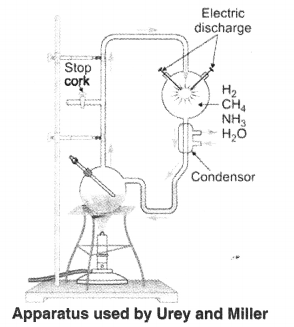
Question 10.
Explain how sexual reproduction gives rise to more viable variations than asexual reproduction. How does this affect the evolution of those organisms that reproduce sexually ?
[CBSE 2011,2014]
Answer:
During sexual reproduction there is ‘crossing over’ of chromosomes, that gives rise to variations. These variations are inherited and increase the chances of survival of an organism.
- In sexual reproduction variations may occur due to errors in DNA copying.
- There may be variations due to interchange of homologous chromosomes during crossing over of male and female.
-
In sexual reproduction, it is not predetermined that which gamete would fuse with another gamete. It depends only on chance. It is also a reason of variation.
These variations enable the organisms to adapt themselves to the changing conditions and also help to give rise to new species.
Question 11.
How is the equal genetic contribution of male and female parents ensured in the progeny ?
[CBSE 2011, 2013]
Answer:
Genetic material in most organisms is present in pairs of chromosomes. Gametes in the sexually reproducing organisms are formed by the process of meiosis during which half of the genetic material goes into each gamete. When the gametes from male and female parents fuse with each other during sexual reproduction, the normal complement is restored. Half of the genetic material comes from the female and half from the male.
Question 12.
Only variations that confer an advantage to an individual organism will survive in a population. Do you agree with this statement ? Why or why not?
Answer:
Yes, variations that confer an advantage to an individual organism are inherited. The organism can survive longer in an environment and maintain its existence in the population.
NCERT Solutions for Class 10 Science Chapter 9 Heredity and Evolution
Heredity and Evolution: Heredity; Mendel’s contribution- Laws for inheritance of traits, Sex determination : brief introduction; Basic concepts of evolution.
| Board | CBSE |
| Textbook | NCERT |
| Class | Class 10 |
| Subject | Science |
| Chapter | Chapter 9 |
| Chapter Name | Heredity and Evolution |
| Number of Questions Solved | 29 |
| Category | NCERT Solutions |
Formulae Handbook for Class 10 Maths and Science
Page 143
Question 1.
If a trait A exists in 10% of a population of an asexually reproducing species and a trait B exists in 60% Of the same population, which trait is likely to have arisen earlier ?
Answer: As species are asexually reproducing, there would be only very minor differences generated due to small inaccuracies in DNA copying, so trait B, which exists in 60% of the same population may get inherited earlier while trait A, which exists in 10% of the population may be originated late due to variations. Thus, trait B have arisen earlier since it is present in 60% of the same population.
Question 2.
How does the creation of variations in a species promote survival ?
Answer: Natural selection selects the individuals having useful variations which ensure their survival in the prevailing conditions of environment. Variant individuals that can withstand or cope with prevailing environment will survive better and will increase in number through differential reproduction.
More Resources for CBSE Class 10
- NCERT Solutions
- NCERT Solutions for Class 10 Science
- NCERT Solutions for Class 10 Maths
- NCERT Solutions for Class 10 Social
- NCERT Solutions for Class 10 English
- NCERT Solutions for Class 10 Hindi
- NCERT Solutions for Class 10 Sanskrit
- NCERT Solutions for Class 10 Foundation of IT
- RD Sharma Class 10 Solutions
Page 147
Question 1.
How do Mendel’s experiments show that traits may be dominant or recessive ?
Answer:
Mendel took pea plants with contrasting characteristics – tall plant and dwarf (short) plant. On cross pollination, he got all tall plants in F1 generation. Then by self pollination of F1 tall plants, he produced second generation (F2) consisting of tall and short plants in the ratio of 3 : 1. Then he concluded that, ‘T’ (tall) trait is dominant while ‘t’ trait for shortness is recessive.
Download NCERT Solutions for Class 10 Science Chapter 9 Heredity and Evolution PDF
Question 2.
How do Mendel’s experiments show that traits are inherited independently ?
Answer:
In a dihybrid cross made by Mendel, it was observed that when two pairs of traits or characters were considered; each trait expressed independent of the other. Thus, Mendel was able to propose the Law of Independent Assortment which says about independent inheritance of traits.
Question 3.
A man with blood group A marries a woman with blood O and their daughter has blood group O. Is this information enough to tell you which of the traits – blood group A or O is dominant ? Why or why not ?
Answer:
No. This information is not sufficient to determine which of the traits − blood group A or O − is dominant. This is because we do not know about the blood group of all the progeny.Blood group A can be genotypically AA or AO. Hence, the information is incomplete to draw any such conclusion.
Question 4.
How is the sex of the child determined in human beings?

Answer:
The females carry two X-chromosomes. Females produce one type of gametes (eggs) with same type of chromosomes (22 + X). Males have one X and one Y- chromosome. Among the male gametes, half of the sperms carry X-chromosome (22 X) and half
carry Y-chromosome (22 + Y). Thus, female is homogametic and male is heterogametic. When a sperm carrying X- chromosome fertilises an egg, the zygote develops into female (XX condition). When sperm carrying Y-chromosome fertilises an egg, the zygote develops into a male (XY condition). Thus, sex is determined at the time of fertilisation.
Page 150
Question 1.
What are the different ways in which individuals with a particular trait may increase in a population ?
Answer:
Different ways are : variation, natural selection and genetic drift (isolation).
Question 2.
Why are traits acquired during the lifetime of an individual not inherited ?
Answer:
Because acquired characters bring changes only in non-reproductive tissues and cannot change the genes of the germ cells. Thus, acquired traits cannot be passed to next generation.
Question 3.
Why are the small numbers of surviving tigers a cause of worry from the point of view of genetics ?
Answer:
(i) If any natural calamity occurs and kills these small number of surviving tigers, they can become extinct resulting in the loss of some genes forever.
(ii) Small number will lead to little recombination and, therefore, lesser variations. These both are very important for giving better survival chances to the species.
(iii) Less number of species means lesser extent of diversity and lesser number Of traits which reduces the chances of adaptability with respect to the change in the environment.
Page 151
Question 1.
What factors could lead to the rise of a new species ?
Answer:
Genetic variations, natural selection and reproductive isolation could lead to the rise of a new species.
Question 2.
Will geographical isolation be a major factor in the speciation of a self-pollinating plant species ? Why or why not ?
Answer:
No, because pollination occurs on the same plant in self-pollinating plant species.
Question 3.
Will geographical isolation be a major factor in the speciation of an organism that reproduces asexually ? Why or why not ?
Answer:
No, because asexual reproduction involves single parent or organism.
Page 156
Question 1.
Give an example of characteristics being used to determine how close two species am in evolutionary terms ?
Answer:
Homologous organs, analogous organs and vestigial organs help to identify evolutionary relationships amongst the species.
Question 2.
Can the wing of butterfly and the wing of a bat be considered homologous organs ? Why or why not ?
Answer:
No, wing of a bat and wing of a bird cannot be considered as homologous organs because they have different basic structure.
Question 3.
What are fossils ? What do they tell us about the process of evolution ?
Answer:
Fossils are the impression or remains of ancient life found preserved in the sedimentary rocks. Fossils are direct evidences of evolution. Fossils also help to identify evolutionary relationship between apparently different species. They also tell about the extent of evolution that has taken place.
Page 158
Question 1.
Why are human beings who look so different from each other in terms of size, colour and looks said to belong to the same species ?
Answer:
They look different because of interaction of genes with environment which results in change in their appearance. But they belong to the same species as they have same number of chromosomes and can breed among themselves.
Question 2.
In evolutionary terms, can we say which among bacteria, spiders, fish and chimpanzees have a ‘better body design’ why or why not ?
Answer:
No, because different designs are the product of evolution and different species have different body design to suit or adapt to their environment.
Page 159
Question 1.
A Mendelian experiment consisted of breeding tall pea plants bearing violet flowers with short pea plants bearing whfte flowers. The progeny all bore violet flowers, but almost half of them are short. This suggests that the genetic make-up of the tall parent can be depicted as
(a) TTWW
(b) TTww
(c) TtWW
(d) TtWw
Answer:
(c) Genetic make-up of tall plant can be depicted by TtWW.
Question 2.
An example of homologous organs is
(a) our arm and a dogs fore-leg.
(b) our teeth and an elephants tusks.
(c) potato and runners of grass.
(d) All of the above.
Answer:
(d) Both organs in all options have same basic structural design but have different functions and appearance.
Question 3.
In evolutionary terms, we have more in common with
(a) a Chinese school-boy.
(b) a chimpanzee.
(c) a spider.
(d) a bacterium.
Answer:
(a) A Chinese school-bpy is also a human being.
Question 4.
A study found that children with light-coloured eyes are likely to have parents with light-coloured eyes. On this basis, can we say anything about whether the light eye colour trait is dominant or recessive? Why or why not?
Answer:
We can say that light eye colour trait is dominant because only dominant traits are expressed in the first generation.
Question 5.
How are the areas of study – evolution and classification— inteilinked?
Answer:
Evolution and classification are interlinked with each other in many ways. Classification is the most important term to explain evolution. It is based on the similarities and differences between two species or among two organisms. More closer the characteristics, the moe doser is the evolution and chances to be in the same group of classification. Thus, the classification of species is a reflection of their evolutionary relationship.
Question 6.
Explain the terms analogous and homologous organs with examples.
Answer:
Analogous organs are those organs which have different basic structural designs and developmental origins but have similar appearance and perform similar functions.
Examples:
Wings of an insect and wings of a bat.
Homologous organs are those organs which have the same basic structural design and developmenta’ origin but have different functions and appearance.
Examples: Forelimbs of frog and forelimbs of human.
Question 7.
Outline a project which alms to find the dominant coat colour in dogs.
Answer:
A homozygous black (RB) male dog and a homozygous white (bb) female dog is taken and given to mate and produce offspring in F1 generation. If black colour is dominant out of every 4 dogs, 3 will be black and if white colour is dominant 3 out of 4 dogs will be white.
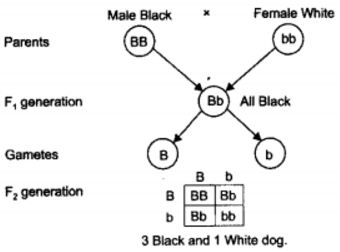
Question 8.
Explain the importance of fossils in deciding evolutionary relationships.
Answer:
Fossils and their study is useful to know about the species which are no longer alive. They provide evidence and missing links between two classes. They are helpful in forming a sequence of organisms in the pathway of evolution. Thus, fossils have importance in deciding evolutionary relationships.
Question 9.
What evidence do we have for the origin of life from inanimate matter?
Answer:
Stanley L. Miller and Harold C. Urey provided evidence regarding origin of life from inanimate matter. They assembled an atmosphere similar to that existed on early earth. The atmosphere had molecules like ammonia, methane, hydrogen sulphide and water, but no oxygen. The mixture was maintained at a temperature just below 100◦C and sparks were passed through the mixture of gases. At the end of a week, 15% carbon from methane had been converted to simple compounds of carbon like aminoacids which make up protein molecules. So, life arose afresh on earth.
Question 10.
Explain how sexual reproduction gives rise to more viable variations that asexual reproduction. How does this affect the evolution of those organisms that reproduce sexually ?
Answer:
Variations occurring during sexual reproduction may be due to:
- Separation of homologous chromosomes (by chance only) during gamete formation.
- Crossing over (recombination) of homologous chromosomes.
- Fertilisation of gametes to form zygote.
- Errors during DNA copying or mutations.
In asexually reproducing organisms only errors during DNA copying or mutations cause variations.
Since the extent of variations is much larger in sexually reproducing organisms, therefore, the chances of evolution is also much in sexually reproducing These variations enable the organisms to adapt themselves to the changing conditions and also help to face the struggle for Over the time, they and rise to new species.
Question 11.
How is the equal genetic contribution of male and female parents ensured in the progeny?
Answer:
Genetically organisms are of types
(i) Haploid :
They have single set of chromosomes, where each chromosome is represented singly. As the chromosomes are the bearer of genes so haploids have single set of genes. A single gene determines the expression of character.
(ii) Diploid :
‘They have two sets Of homologous chromosomes, where the chromosome occur in pair, one maternal contributed by the mother through her ovum and the second Of the pair is contributed by the male parent through his sperm. The resultant cell zygote produces by the fusion of male and female gametes have two sets of chromosomes – each set contributed’ by each parent. In diploids a character is controlled by two genes/factors. Both the father and mother contribute practically equal amount of genetic material to the child. It means that each trait can be influenced by both paternal and maternal DNA.
Question 12.
Only variations that confer an advantage to an individual organism will survive in a population. Do you agree with this statement ? Why or why not ?
Answer:
No, many of the times the variations are not advantageous to an individual organism but still survive in a population, e.g., take the case of free ear lobe and attached ear lobe. Most of the other variations not only give survival advantage to an individual but also contribute to genetic drift. Thus, we can say that most of the variations lead to better adaptation of an organism to the changing environment. In this way, it gives survival advantage to that organism and will also survive in the coming population.
Multiple Choice Questions (MCQs) [1 Mark each]
Question 1.
An example of homologous organs is
[NCERT]
(a) our arm and a dog’s foreleg
(b) our teeth and an elephant’s tusks
(c) potato and runners of grass
(d) All of the above
Answer:
(a) Our arm and a dog’s foreleg is the example of homologous organs.
Question 2.
The science, which deals with study of heredity and variations is called
(a) phylogeny
(b) embryology
(c) genetics
(d) palaeontology
Answer:
(c) The genetics is the study of heredity and variations and includes their occurrence, causes, benefits, disadvantages, significance, etc.
Question 3.
Archaeopteryx is a connecting link between
(a) reptiles and aquatic animals
(b) birds and insects
(c) reptiles and birds
(d) birds and dinosaurs
Answer:
(c) Archaeopteryx is a connecting link- between the reptiles and birds. It appears like a bird, but has other features which are present in reptiles, e.g. it has wings like bird, but teeth and tail like the reptilians.
Question 4.
For palaeontological studies a scientist will gather the evidences from
(a) study of homology
(b) study of analogy
(c) fossils
(d) All of these
Answer:
(d) Study of homologous and analogous organs indicates the origin and modification in organisms and study of fossils indicates the age and features of an organism.
Question 5.
In evolutionary terms, we have more in common with
[NCERT]
(a) a Chinese school boy
(b) a chimpanzee
(c) a spider
(d) a bacterium
Answer:
(a) Chinese school boy because both of us belong to the same species, i.e. Homo sapiens.
Question 6.
Aditya was observing some organisms in lab and tried to compare them. The presence of which organs will confirm to him that they share evolutionary history?
(a) Analogous organs
(b) Paralogous organs
(c) Homologous organs
(d) None of these
Answer:
(c) Homologous organs are present in organisms who share evolutionary history. However, these organs perform different functions in different organisms.
Question 7.
New species may be formed if
I. DNA undergoes significant changes in germ cells. .
II. chromosome number changes in the gamete.
III. there is no change in the genetic material.
IV. mating does not take place.
(a) I and II
(b) I and III
(c) II, III and IV
(d) I, II and III
Answer:
(a) New species may be formed if the DNA changes are severe enough, such as a change in the number of chromosome. This leads to new variations.
Question 8.
Which of the following statements is not true with respect to variation?
(a) All variations in a species have equal chance of survival.
(b) Change in genetic composition results in variation.
(c) Selection of variants by environmental factors forms the basis of evolutionary processes.
(d) Variation is minimum in asexual reproduction.
Answer:
(a) All variations in a species do not have equal chances of survival. Some of the variations may be so drastic that the new DNA copy cannot work with the cellular apparatus it inherits. Such, a newborn cell dies soon.
Question 9.
Select the statement that describes characteristics of genes. .
(a) Genes are specific sequence of bases in a DNA molecule.
(b) A gene does not code for proteins.
(c) In individuals of a given species, a specific gene is located on a particular chromosome.
(d) Each chromosome has only one gene.
Answer:
(b) Genes are stretches of DNA found on chromosomes of a cell. A gene contains information for making proteins in a cell. A specific gene is located on a particular chromosome in individuals of a given species.
Question 10.
If a round, green seeded pea plant (RRyy) is crossed with wrinkled, yellow seeded pea plant (rrYY), the seeds produced in F1 – generation will be
[NCERT Exemplar]
(a) round and yellow
(b) round and green
(c) wrinkled and green
(d) wrinkled and yellow
Answer:
(a) The cross between RRyy and rrYY seeds will produce RrYy (round and yellow) seeds in F1-generation, because round and yellow are the dominant traits.
Question 11.
From the list given below, select the character, which can be acquired but not inherited. [NCERT Exemplar]
(a) colour of eye
(b) colour of skin
(c) size of body
(d) nature of hair
Answer:
(c) Acquired traits develop in response to the environment. The size of the body is an acquired trait because it can vary based on the availability of less or more food. The other three colour of eye and skin and nature of hair are characters inherited from the parents.
Question 12.
According to the evolutionary theory, formation of a new species is generally due to [NCERT Exemplar]
(a) sudden creation by nature.
(b) accumulation of variations over several generations.
(c) clones formed during asexual reproduction.
(d) movement of individuals from one habitat to another
Answer:
(b) Accumulation of variations over several generations forms new species. Genetic drift accumulates different changes in sub-populations of a species. Also, natural selection may also operate differendy in the different geographic locations. Eventually, different groups of new species will be formed.
Question 13.
Select the incorrect statement.
[NCERT Exemplar]
(a) Frequency of certain genes in a population changes over several generations resulting in evolution.
(b) Reduction in weight of the organism due to starvation is genetically controlled.
(c) Low weight parents can have heavy weight progeny.
(d) Traits which are not inherited over generations do not cause evolution.
Answer:
(b) The weight reduction due to starvation will not change the DNA of the germ cells, because low weight is not a trait that is genetically controlled or inherited. Also, low weight parents may have heavy weight progeny.
Question 14.
In human males all the chromosomes are paired perfectly except one. This/these unpaired chromosome is/are
I. large chromosome
II. small chromosome
III. Y-chromosome IV X-chromosome
(a) I and II
(b) Only III
(c) III and IV
(d) II and IV
Answer:
(c) In human males, one pair called the sex chromosomes are unpaired. Here, one is a normal-sized X-chromosome while other is a short Y-chromosome. Women have a perfect pair of sex chromosomes, both called X.
Question 15.
Rajneesh was studying the fossils of two different types, fossil A was found in upper layer of Earth and B in deeper layers. What can be predicted regarding the age of these fossils?
(a) A has recently become extinct
(b) B has become extinct recently
(c) The time of extinction cannot be determined
(d) None of the above
Answer:
(a) Since, fossil A was found in upper layer of earth, it suggests that the organism has become extinct recently. Fossil B found in deeper layer must have become extinct long time ago and deposition of other layers occurred over it during this period.
Question 16.
A Mendelian experiment consisted of breeding tall pea plants bearing violet flowers with short pea plants bearing white flowers. The progeny all bore violet flowers, but almost half of them were short. This suggests that the genetic makeup of the tall parents can be depicted as
[NCERT]
(a) TTWW
(b) TTww
(c) TtWW
(d) TtWw
Answer:
(c) Parent with genotype TtWW produce two types of gametes TW and tW, while the other with genotype ttww produce only one type of gamete W.
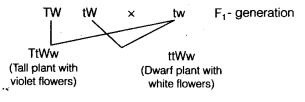
NCERT Solutions for Class 10 Science Chapter 9 Heredity and Evolution (Hindi Medium)
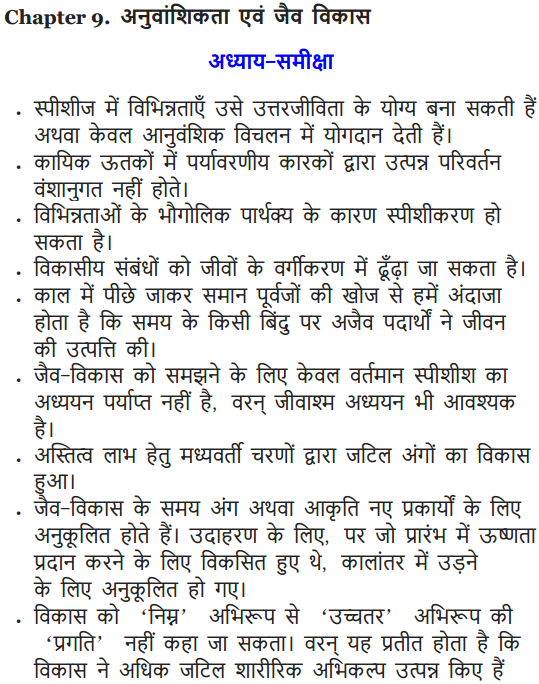
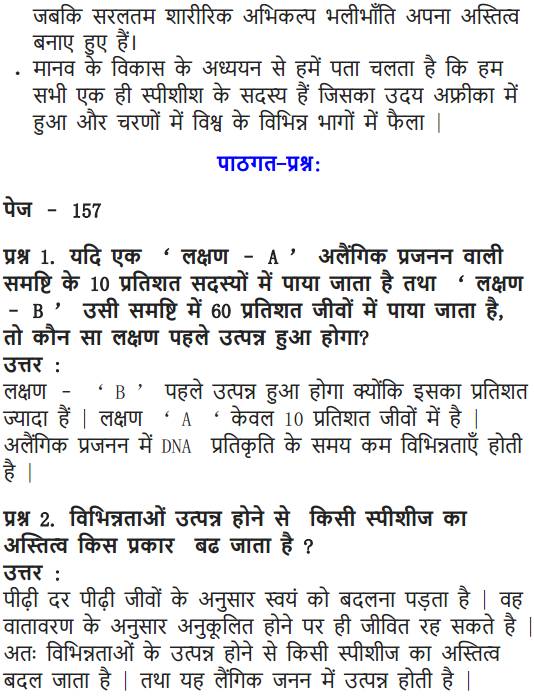
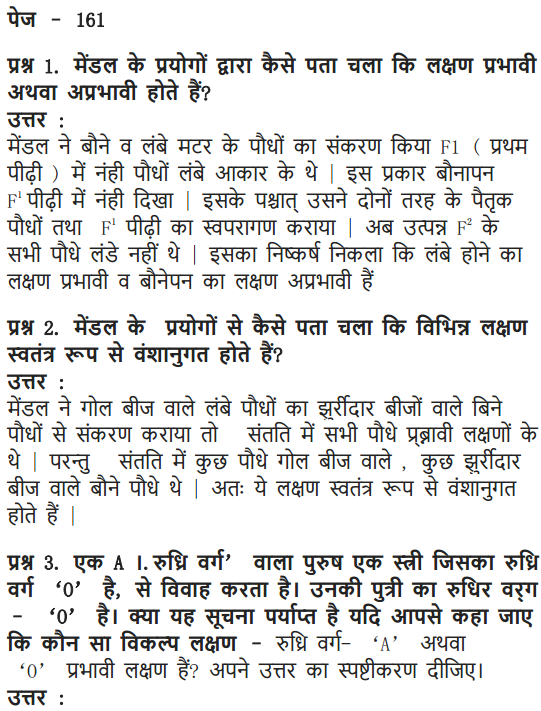
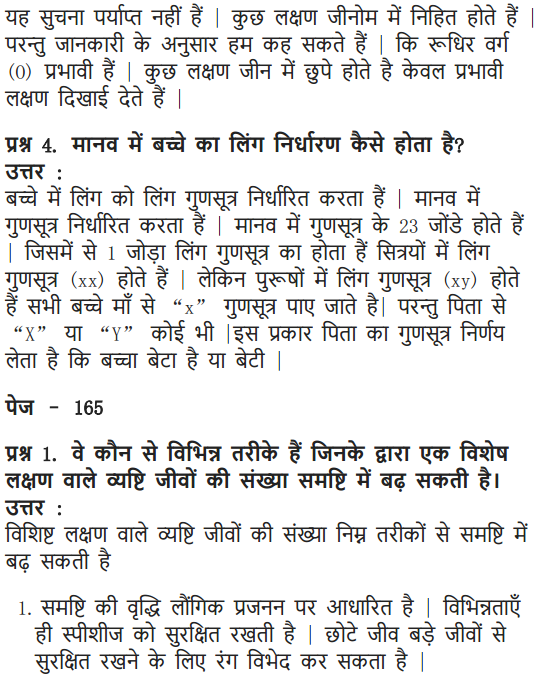
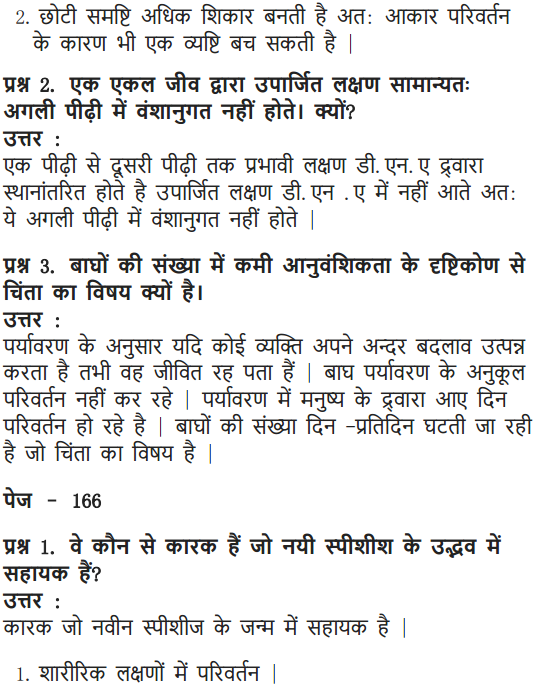
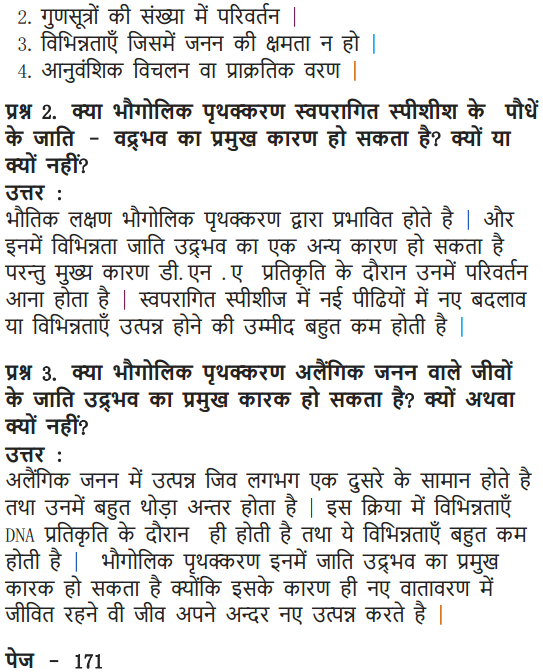
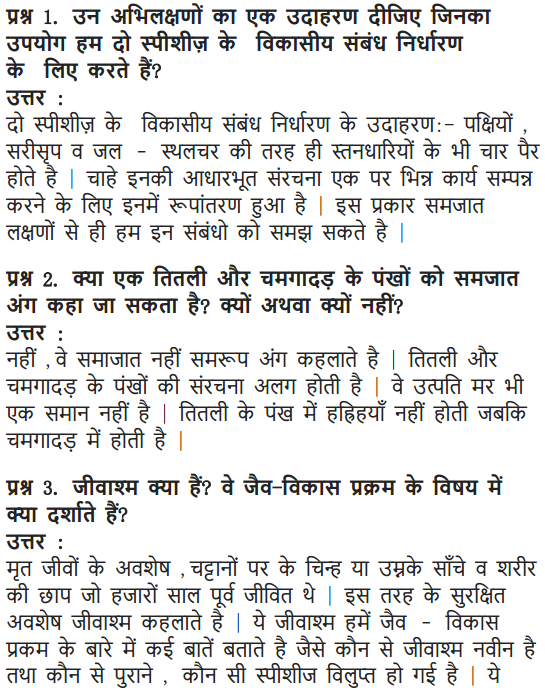
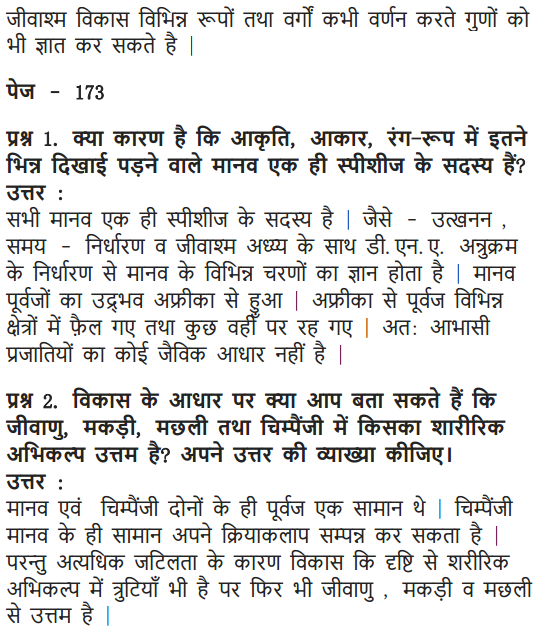
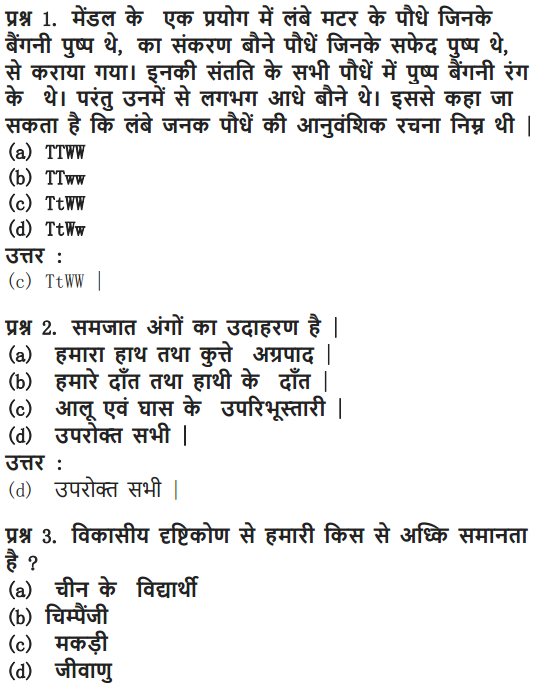
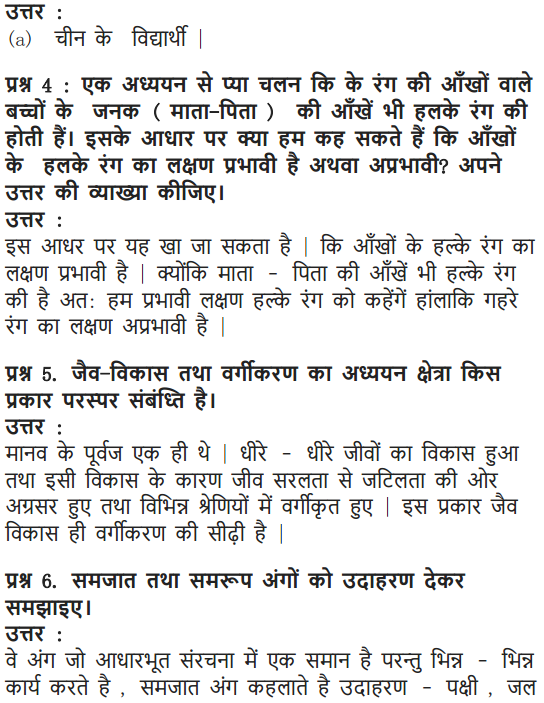
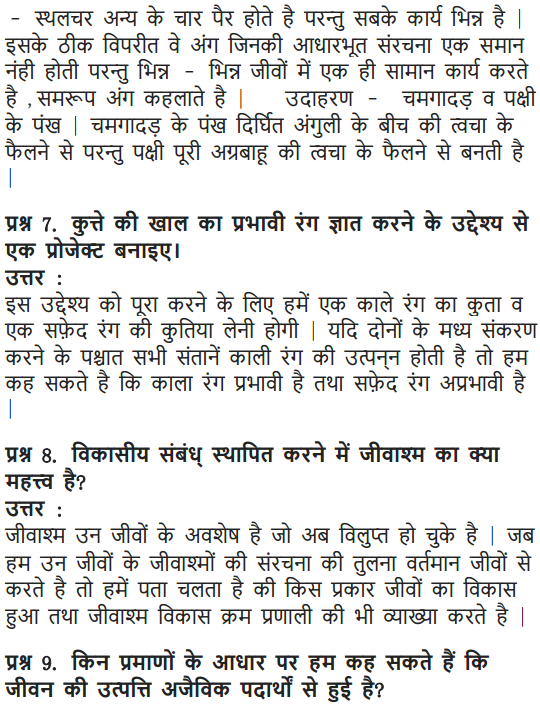
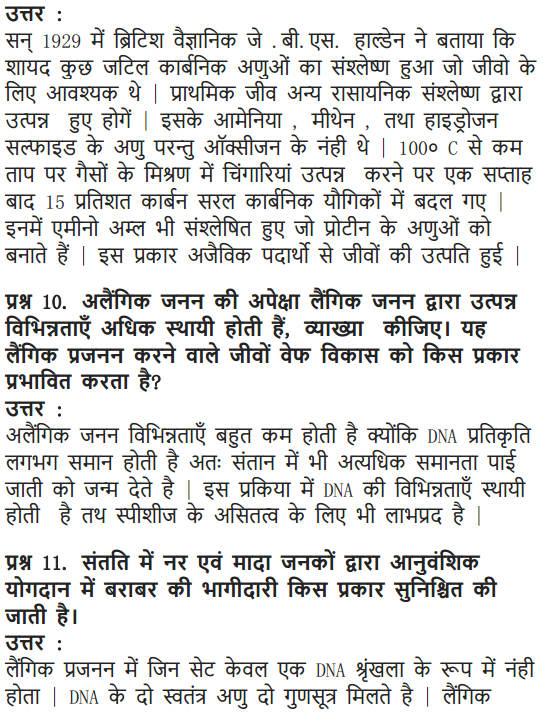
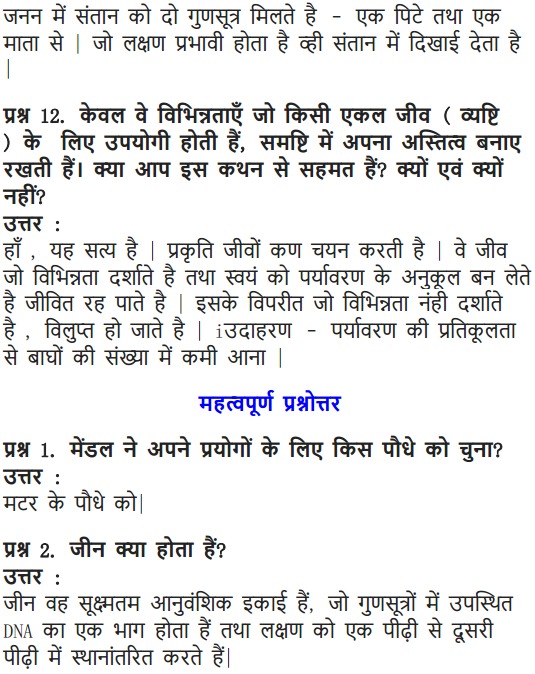
Class 10 Science Heredity and Evolution Mind Map
Accumulation Of Variation During Reproduction
- Characters or features or traits are inherited from one generation to the next during reproduction.
- This inheritance provides both a common basic body design & subtle changes in it for next generation.
- When this generation reproduces, the offspring would have differences they inherit from previous generation as well as newly created differences.
- Accumulation of these differences generation after generation leads to the development of variations in a population.
- Different variations provide different advantages to the population and the variation which provide best survival advantages are inherited to the next generation.
- For e.g. bacteria having variation to tolerate heat will survive and multiply better in heat wave.
Heredity
Heredity refers to the transmission of characteristics from parent to offspring by means of genes in the chromosomes.
Mendel’s Contributions
- Mendel was the first scientist whose studies lead to the formulation of laws of inheritance.
- He conducted cross hybridization experiments of garden pea plant (Pisum sativum) and studied the transmission of characters that had two contrasting traits such as round/wrinkled seeds, tall/short plants, white/’violet flowers etc.
Experiment 1:
He cross pollinate pure breeds of tall (TT) & dwarf (tt) pea plant and calculated the percentages of tall & dwarf progeny.
Observation:
F
1
generation was tall (Tt) with no halfway characteristics.
F
2
generation produced by self pollination of F
1
included tall and short plants in 3:1. (Genotypic ratio 1:2:1 for TT:Tt:tt)
Inference:
This indicates that both the tallness & shortness traits were inherited in the F, plants, but only the tallness trait was expressed.
Thus, two copies of the trait are inherited in each sexually reproducing organism. These two may be identical (TT or tt) or may be different (Tt), depending on the parentage.
Conclusion:
This study leaded to the formulation of two laws:
Law of dominance:
states that only one character expresses itself in F, generation.
Law of segregation:
states that the two alleles of a character in an individual get separated or segregated during gamete formation and distributed randomly in gametes.
Experiment 2:
He crossed the plant with two different characteristics such as tall plant with round seed and short plant with wrinkled seed. Other example may include round & green seeds (RRyy) and wrinkled & yellow seeds (rrYY).
Observation:
F
1
generation; all were tall & round i.e. tall & round are dominant.
F
2
generation; tall plants with round seeds, tall with wrinkled seeds, short with round seeds, and short plants with wrinkled seeds in 9:3:3:1.
Similarly, round & yellow, round & green, wrinkled & yellow, and wrinkled & green in 9:3:3:1.
Inference:
The tall/short trait and the round seed/wrinkled seed trait are independently inherited.
Conclusion:
It formulated the law of independent assortment which states that genes of different characters located in different pairs of chromosomes are independent of one another in their segregation during gamete formation.
Sex Determination
Different species use different strategies for this:
- Environment: for e.g. the temperature at which fertilised eggs are kept determines the sex of developing animals in the eggs. It is observed in animals like crocodile, turtle etc.
- Snails can change sex. indicating that sex is not genetically determined.
-
Sex of an individual is genetically determined for e.g. humans.
- Humans have 22 autosomal & 1 sex chromosome pairs. Females have XX & males have XY. Hence, sex of a child is determined by what he/she has inherited (X or Y) from the father since, child will always inherit X from the mother. If X is inherited from father then child will be a girl & if Y is inherited then a child will be a boy.
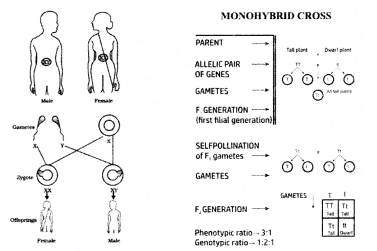
Evolution
- It refers to gradual change in the characteristics of the population (plants & animals) over successive generations.
- Errors in DNA copying during reproduction, mutations, & natural selection account for the evolution.
- Evolution gives rise to such a biodiversity at each level of biological organization such as at species level, among individuals, molecules etc.
Evolution And Classification
Classification is the process by which organisms are grouped into convenient categories based on some easily observable characters.
Characters such as cell type (prokaryote or eukaryote), single cell or multi cellular, presence or absence of nucleus, autotrophic (such as photosynthesis) or heterotrophic, sexual or asexual reproduction etc. are used to classify different organisms in different groups.
The more characteristics two species will have in common, the more closely they are related. And the more closely they are related, the more recently they will have had a common ancestor. For e.g. brother & sister are more closely related than a girl & her first cousin. Therefore, classification of species gives a reflection of their evolutionary relationship.
Tracing Evolutionary Relationships
Few evidences which help us to trace evolutionary
relationships among different organisms or species:
-
Comparative anatomy and morphology:
study of similarities & differences among organisms to understand the common ancestry’.
- Homologous: Similar structure different functions. It indicates common ancestry for e.g. bones of forelimbs in frog, lizard, bird & human.
- Analogous: Similar functions but different structure. Different structures evolved for same function & hence having similarity. For e.g. wings of bats & birds, eye of octopus & mammals, etc.
-
Fossils:
Remains of hard parts of life-forms found in rocks. They represent extinct organisms (e.g., Dinosaurs).
- The age of the fossils can be estimated by two ways; relative depth of the fossils, dating fossils i.e. detection of ratios of different isotopes of the same element in the fossil material
Speciation
- It refers to a gradual evolutionary process by which populations evolve to become different species.
- Reproductive and geographical isolation play an important role in the process of speciation. They result in change in the frequency of an existing gene variant in a population i.e. genetic drift.
- Over generations, genetic drift along with natural selection results in the formation of new’ species,
- Other factors that may result in speciation are sudden severe DNA changes (mutation) such as change in chromosomal no., variation such as female green beetle will not mate with red males. Her behavior ensures the reproductive isolation between them and thus results in generation of new’ species.
Evolution Should Not Be Equated With ‘progress’
- Evolution is simply the generation of diversity & shaping of diversity by environmental selection.
- The only progressive trend in evolution seems to be the emergence of more and more complex body designs over time. However, that doesn’t mean that the older designs are inefficient.
- For e.g. simplest life forms; bacteria inhabits the most inhospitable habitats like hot springs, deep-sea thermal vents & ice in Antarctica.
Human Evolution
- Tolls, like excavating, time-dating and studying fossils, determining DNA sequences etc, have been used for studying human evolution.
- All humans are a single species regardless of skin color or human races.
- The earliest members of the human species, Homo sapiens, can be traced back to Africa i.e. we all come from Africa.
- A couple of hundred thousand years ago, some of our ancestors left Africa while others stayed on.
- The migrants slowly spread across the planet; from Africa to West Asia, then to Central Asia, Eurasia, South Asia, & East Asia.
- They travelled down the islands of Indonesia and the Philippines to Australia, and they crossed the Bering land bridge to the Americas.
We hope this detailed article on NCERT Solutions For Class 10 Science Chapter 9 Heredity and Evolution is helpful. If you have any query regarding this article or NCERT Solutions For Class 10 Science Chapter 9 Heredity and Evolution, leave your comments in the comment section below and we will get back to you as soon as possible.
NCERT Solutions for Class 10 Science All Chapters
- Chapter 1 Chemical Reactions and Equations
- Chapter 2 Acids, Bases and Salts
- Chapter 3 Metals and Non-metals
- Chapter 4 Carbon and Its Compounds
- Chapter 5 Periodic Classification of Elements
- Chapter 6 Life Processes
- Chapter 7 Control and Coordination
- Chapter 8 How do Organisms Reproduce?
- Chapter 9 Heredity and Evolution
- Chapter 10 Light Reflection and Refraction
- Chapter 11 Human Eye and Colourful World
- Chapter 12 Electricity
- Chapter 13 Magnetic Effects of Electric Current
- Chapter 14 Sources of Energy
- Chapter 15 Our Environment
- Chapter 16 Management of Natural Resources